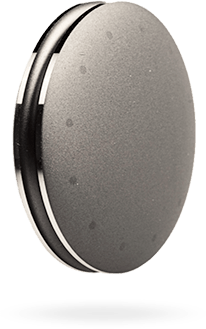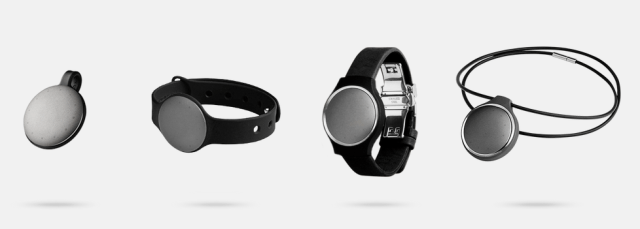Fitbits. FuelBands. UPs. The market for smart, connected activity trackers continues to get ever-more crowded. And yet, there’s not an obvious winner yet.
Misfit Wearables’ Shine is a new entrant in the space and they may have the most beautifully-designed piece of hardware yet. The company behind the Shine is itself a homage to Apple founder Steve Jobs’ famous “Think Different” campaign and the famous 1997 commercial that began with the line, “Here’s to the crazy ones. The misfits.”
Backed by Founders Fund and Khosla Ventures, the company was co-founded by Sonny Vu, who built up a glucose-monitoring business called Agamatrix that had the first official medical device add-on to the iPhone, and former Apple CEO John Sculley. For a small startup, they have an impressively multi-national team with industrial designers in San Francisco, data scientists in Vietnam and manufacturing in South Korea and Japan.
The Shine is a tiny circle not much larger than a quarter that’s made from Japanese metal or aircraft-grade aluminum. It has LED lights beneath the surface that glow through minuscule holes on the metal itself. Those lights form a ring, indicating how far a person is toward completing their activity goals for the day. You tap the Shine twice to see how much progress you’ve made. If half the lights shine, you’re halfway done. If they complete a circle, then you’ve hit your goal.
I had a chance to test it out for a week or so, tracking everything from regular walks to dancing and downhill mountain biking.
Overall, I love the product. It looks like a piece of jewelry in many ways, and while I’m not an industrial designer myself, several other friends who work in hardware were impressed by the make and form of the Shine.
It is not plastic like a Fitbit. Then because it doesn’t have to be worn as a bracelet like the FuelBand or Jawbone UP, it looks a lot more elegant, especially if you’re a woman and want something more discreet. The Shine is comparable in price to its competitors at $99.95. The Fitbit is about $99.95, the Jawbone UP is $129.99 and the Nike FuelBand is about $150.
The Shine has four different accessories: a wristband, a necklace, a watch and a magnetic clip that makes it easy to attach anywhere, from your shoe to your sleeve to your shirt. My preferred accessory was the magnetic clip, but I didn’t have a chance to try out the necklace or watch.
Throughout the day, the Shine tracks how much you walk or run. It also handles sleep, swimming and cycling, but you have to program it. To do that, you tap the Shine three times, and it will recognize whichever activity you set up in the paired app. Unfortunately, like the other activity trackers, it doesn’t handle yoga (and as someone who practices pretty much every day, the Shine and other competing products are missing out on an hour of physical activity).
The tapping is a bit hard to learn. Sometimes I would tap with two fingers and sometimes with three. Sometimes the Shine would misinterpret a few taps as a signal to record a different type of activity instead of showing me my results so far. You can also use it to tell time with different lights glowing to represent the hour and minute hands of a watch.
“The data science to get the double tap is hard,” Vu told me. “There is no on and off button for the Shine and everything is powered by sensors.”
Indeed, the only way to turn the Shine off is for the battery to run out or for you to remove it.
That underscores the huge benefit of the Shine, which is that it doesn’t need to be charged every few days or weeks. It has a simple coin cell battery that needs to be replaced once every four to six months. It’s also waterproof to a depth of 50 meters. I dunked it in a river in the Sierra Nevadas this weekend and it came out fine, but you could theoretically scuba dive with it, too.
The data transfer to the iPhone is also beautiful. You can see how it works below. The Shine uses a simple Bluetooth connection, and the app directs you to place the Shine on a circle on the iPhone app’s screen. Circles radiate outward before the iPhone picks up the activity data in the Shine.
The paired app tells you how many points you’ve achieved in a day. The Shine doesn’t do “steps” because it would be hard to swim in steps. The middle-range goal of 1,000 points per day requires walking for 1.5 hours, running for 35 minutes or swimming for 25. You can move points higher as you please.
Overall, I was really happy with the product. It is just that much more beautiful looking than the standard Fitbit or FuelBand. For women who are turned off by the look of the bracelet trackers, it’s probably the ideal choice.
The Misfit Shine is only compatible with the iPhone for now, which was surely disappointing for Android-using supporters of the Shine who backed it on Indiegogo.
The company had a successful campaign on the crowdfunding site late last fall where they racked up 8,000 supporters in 64 countries, hit their goal in nine hours and went on to raise $850,000. That was nearly nine times as much as they targeted. Like many other hardware startups, Misfit Wearables used crowdfunding more as a marketing strategy than as a capital source. Misfit had no problem raising from some of the Valley’s better-known VC firms, and this product shows why.

